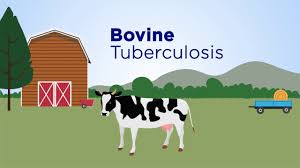Bovine tuberculosis is a chronic infectious illness that mostly affects cattle but can also infect humans and other domestic and wild animals. The bacterium Mycobacterium bovis is to blame.
Etiology of Bovine Tuberculosis:
The etiology of Bovine Tuberculosis (bTB) is primarily attributed to the bacterium Mycobacterium bovis. Mycobacterium bovis is a member of the Mycobacterium tuberculosis complex, which also includes Mycobacterium tuberculosis, the causative agent of human tuberculosis. These bacteria are characterized by their unique cell wall structure, rich in lipids, which imparts resistance to many disinfectants and antibiotics. Mycobacterium bovis is a slow-growing, acid-fast bacterium, meaning it retains its staining even after exposure to acid, a property that helps in its identification.

Bovine tuberculosis is mainly transmitted through the inhalation of respiratory secretions containing Mycobacterium bovis, but it can also spread through the ingestion of contaminated feed, water, or milk. This bacterium has a remarkable ability to evade the host’s immune system and establish latent infections, making it difficult to detect and control. Understanding the etiology of bTB is crucial for implementing effective prevention and control measures, including diagnostic tests, culling infected animals, and research into potential vaccines and treatment strategies for both livestock and humans at risk of zoonotic transmission.
Hosts Range:
Cattle are the main victims of bovine TB. However, it can also spread to other kinds of wildlife, including sheep, goats, pigs, deer, and others. Close contact with sick animals or intake of raw milk or dairy products from infected cows can lead to human infection.
Pathogenesis of Bovine Tuberculosis:
The pathogenesis of Bovine Tuberculosis (bTB) is a complex process that begins when cattle become infected with the bacterium Mycobacterium bovis. Infection typically occurs through inhalation of respiratory secretions containing the bacterium or ingestion of contaminated feed or water. Once inside the host, the bacterium is phagocytosed by macrophages, a type of immune cell, but it can evade the immune system’s initial response. Mycobacterium bovis has developed various mechanisms to resist destruction within the macrophages and establish a persistent infection. As the infection progresses, granulomas, which are organized collections of immune cells and bacteria, form at the site of infection. These granulomas can be found in various organs, most commonly in the lungs, lymph nodes, and, in some cases, in the udder. Bovine Tuberculosis can remain latent for extended periods, during which the bacteria are contained within granulomas, but it can later re-activate and spread, leading to clinical disease. The disease’s progression can result in characteristic lesions, impaired immune responses, and the shedding of Mycobacterium bovis through various routes, making it a concern for both animal health and public health, as it can be zoonotic, potentially affecting humans who come into contact with infected animals or their products. Controlling and preventing Bovine Tuberculosis in cattle is a significant challenge due to its intricate pathogenesis and the need for comprehensive management strategies.

Transmission of Bovine Tuberculosis:
Bovine tuberculosis is mostly spread by close contact between susceptible and diseased animals. Ingestion of tainted food or water, inhalation of respiratory droplets carrying the bacteria, or direct contact with infected tissues or fluids can all result in this. Control and eradication are more difficult because transmission between wildlife species and cattle can also happen.
Clinical indications of Bovine Tuberculosis:
- Not all infected animals will exhibit all of the clinical indications of bovine tuberculosis.
- Affected cattle may display chronic coughing
- weight loss
- decreased milk output
- weakness
- lethargy in severe cases
- Around the lymph nodes, especially in the neck or throat area, lumps or abscesses may be felt.
- Some animals may not exhibit overt symptoms of disease.
Diagnosis of TB:
Bovine tuberculosis can be identified using a combination of laboratory tests, tuberculin skin tests, and clinical examinations. A pure protein derivative (PPD) from M. bovis is injected under the skin during a tuberculin skin test to assess the immunological response. Positive test findings suggest exposure or infection, necessitating additional confirmation through laboratory tests such bacterial culture or polymerase chain reaction (PCR) testing.
Necropsy findings:
Characteristic lesions can be seen during the post-mortem examination. These include the lymph nodes, lungs, and other organs’ lymphomas or tubercles. The damaged tissues may be calcified or have caseous (cheese-like) material in the lesions.

Treatment of Bovine Tuberculosis:
- There is no effective treatment for animal cases of bovine TB.
- Infected animals are often killed to stop the sickness from spreading.
- In some circumstances, individual animals might have extended isolation and testing to make sure they are infection-free before being reintroduced to the herd. This strategy, nevertheless, requires a lot of resources and is not always practical.
- For more details click here
Prevention and control of T.B:
Bovine tuberculosis can be prevented and controlled by utilizing a variety of methods. Regular testing and surveillance, testing and quarantining of recently introduced animals, stringent biosecurity precautions, and, in some situations, vaccination are among them. Restrict and eradication programs are frequently performed in areas where bovine tuberculosis is widespread in order to locate and eliminate diseased animals, restrict wildlife reservoirs, and reduce transmission between cattle herds. Pasteurization of milk and dairy products also aids in the prevention of human infection.
- For video demonstration of different cases click here.
For specific advice on the prevention, diagnosis, and control of bovine tuberculosis, it is vital to speak with veterinary experts and local authorities. This is because the strategy may differ depending on the area and the disease’s prevalence.


1 thought on “Bovine Tuberculosis: What You Need to Know About TB in Cattle”